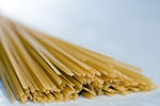
Linguine
Encyclopedia

Pasta
Pasta is a staple food of traditional Italian cuisine, now of worldwide renown. It takes the form of unleavened dough, made in Italy, mostly of durum wheat , water and sometimes eggs. Pasta comes in a variety of different shapes that serve for both decoration and to act as a carrier for the...
— flat like fettuccine
Fettuccine
Fettuccine is a type of pasta popular in Roman Cuisine. It is a flat thick noodle made of egg and flour wider than but similar to the tagliatelle typical of Bologna...
and trenette
Trenette
Trenette are a type of narrow, flat, dried pasta especially associated with Genoa and Liguria.Trenette are the most traditional form of pasta served with pesto alla genovese, a dish known as trenette al pesto, which can also include potatoes and green beans boiled in the same water.-Bibliography:*...
. It is wider than spaghetti
Spaghetti
Spaghetti is a long, thin, cylindrical pasta of Italian origin. Spaghetti is made of semolina or flour and water. Italian dried spaghetti is made from durum wheat semolina, but outside of Italy it may be made with other kinds of flour...
, about 1/4 to 3/8 inch, but not as wide as fettuccine. The name linguine means "little tongues" in Italian
Italian language
Italian is a Romance language spoken mainly in Europe: Italy, Switzerland, San Marino, Vatican City, by minorities in Malta, Monaco, Croatia, Slovenia, France, Libya, Eritrea, and Somalia, and by immigrant communities in the Americas and Australia...
, where it is a plural of the feminine linguina. Linguine are also called trenette or bavette. A thinner version of linguine is called linguettine.
Linguine originated in Genua and the Liguria
Liguria
Liguria is a coastal region of north-western Italy, the third smallest of the Italian regions. Its capital is Genoa. It is a popular region with tourists for its beautiful beaches, picturesque little towns, and good food.-Geography:...
region of Italy
Italy
Italy , officially the Italian Republic languages]] under the European Charter for Regional or Minority Languages. In each of these, Italy's official name is as follows:;;;;;;;;), is a unitary parliamentary republic in South-Central Europe. To the north it borders France, Switzerland, Austria and...
. Linguine alle vongole (linguine with clam
Clam
The word "clam" can be applied to freshwater mussels, and other freshwater bivalves, as well as marine bivalves.In the United States, "clam" can be used in several different ways: one, as a general term covering all bivalve molluscs...
s) and Trenette al pesto
Pesto
Pesto is a sauce originating in Genoa in the Liguria region of northern Italy , and traditionally consists of crushed garlic, basil and pine nuts blended with olive oil and Parmigiano Reggiano and Fiore Sardo...
are popular uses of this pasta.
While spaghetti traditionally accompanies meat and tomato dishes, linguine are often served with seafood or pesto. Linguine is typically available in both white-flour and whole-wheat versions; the latter are usually made in Italy. Because the individual strands of linguine are bulkier than spaghetti, and thus have a higher ratio of volume to surface area, linguine must be cooked slightly longer in order to achieve the same degree of doneness.

